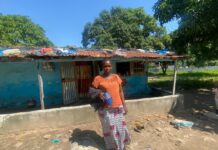
By: Foday Manneh
Several online sources, mainly in the United Kingdom (UK), report that “Red Rock” is the Gambia’s highest point, standing at 53 meters (174 feet) above sea level.
The rock is located in the Eastern part of The Gambia in Wuli, Upper River Region (URR).
While the exact location of the rock remains unknown, interest in finding the place is growing among tourists, and several villages have been suspected of locating it.
In November 2021, a group of tourists from the UK, mainly from Scotland and England visited The Gambia to locate the rock. A trip accompanied by TAT’s reporter at the time in URR.
The location of the highest hill point was not known before this trip. Upon arriving in the region, Beriffu village in Wuli East was their first call — unfortunately, villagers there could not identify any specific evidence close to their findings.
However, one of the villagers would come to the aid of the visitors and reveal all he knew. He told them the place could be in Nyakoi Madina, a Wuli West village.
As they moved towards the identified spot, one of the tourists used his mobile phone to map out highly elevated and tall structures in the said area but to no avail until they arrived in Nyakoi Madina.
In Madina, they were taken to a hill that the villagers consider not only the highest rock but a place with an inspiring story.
On the hill, visitors thought they had finally found the red rock in Madina because of its height and view from where almost all corners of the region, including the river Gambia, can be easily discerned.
The lack of records to confirm whatever they discovered was a major stumbling block in the expedition’s ability to ascertain the veracity of the communities’ claims.

Meanwhile, the rock in Madina has some symbolic markings, such as its reddish color and a pillar built on it by some Europeans back in 1969 and wordings that say “GP34 – 1969”.
When TAT returned to the village in December 2022, we met Kemo Camara, a native with a good memory of the hills. He was on holiday from abroad.
Kemo, in his 80s, told this medium what happened when two Europeans reportedly came to the village in 1969.
“They came and confirmed if they were exactly at Nyakoi Madina by asking three times. They told us they came for a survey on the hills and were sent by the government of the UK,” he said.
Kemo and two others were the escorts of the visitors to the site, and he was inquisitive at the time to know more about the purpose of the visit.
“On the hills, the oldest among them used his equipment to do a survey. Then, after every identified part on the hill, he will ask us to build a pillar. Those are the pillars we still have there.”

“They did not tell us what exactly was there, but we suspected that the hill could hold minerals deposits,” Kemo said.
Madina was the first settlement of the combined Nyakoi setting in Wuli West. The village has a popular history of how they settled in their current homes.

Behind those Baobab trees was the first settlement of the village, but a clash between the villagers and what they called “Jinns” forced them to resettle to their new and current homes.
“In our first settlement, we were isolated and exposed to many things, including Jinns. So we stayed with them,” said Ousubi Camara, an old native.
“We have more than 1000 inhabitants, and farming was key for our livelihoods. We have farms around the riverside, and we needed to demarcate a route to access them at the time.”
According to Ousubi, a clash erupted between them and the Jinns due to their plans to start a passage to access their farms.

“You will hear them talking to you but won’t see them. They told us we cannot start a way there, but we stood up against that,” he explained.
“During that clash, one night, a fire broke out in one compound and ravaged the entire village. No home was spared. After that, a few days later, we could blindly hear them (Jinns) provoking us,” Ousubi recalled.
The magnitude of that inferno reportedly forced the people of Nyakoi Madina to resettle some kilometers away from their old village, where they live happily and perhaps safely.
TAT talked with several Gambian historians regarding the correct location of “Red Rock,” but all efforts proved fruitless.
Nyakoi Madina’s story probes the Gambia’s richly diverse heritage and history. As the saga of red rock and The Gambia’s tallest hill remains unanswered, the village is gradually becoming a major attraction for tourists and historians.





